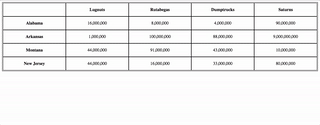Nuisance Wildlife Control Operators in Illinois
By Anderson Wiese, Founder Last year I blogged about Nuisance Animal Removal Permits for citizens of Illinois. For th Read more...

Making a responsive table that doesn’t lose readability is pretty tough. Here’s our shot.
Back in March, 2wav alumni and frontend expert Brian Walters (@bdubcodes) tweeted about his struggles with tables on mobile devices. (Farther down we’ve posted a version of this implementation that doesn’t require CSS variables.)
Yo I’ve been a web developer since 2008 and I still can’t style a table to be flexible and responsive —Brian Walters 🤜💥🐸 (@BDubCodes)
As web designers, we’ve gotten used to a basic responsive design pattern where we collapse multiple columns down as we shrink the width of the viewport:

Of course, this poses a real challenge with tables. Because each column in the table has data about the specific item, there isn’t a good way to start stacking columns. Instead, most implementations just shrink the cells, which gets pretty ugly if you have a lot of columns.
Brian’s tweet got us thinking about this problem. We decided on a few goals:
Here’s what we came up with.
Let’s start with the HTML for the table. As you can see, the markup looks like you’d expect for a table. We said we wanted to make the experience seem as normal as possible, and we meant it.
<table>
<tr>
<th></th>
<th>Lugnuts</th>
<th>Rutabegas</th>
<th>Dumptrucks</th>
<th>Saturns</th>
</div>
<tr>
<th>
<p>Alabama</p>
</th>
<td>
16,000,000
</td>
<td>
8,000,000
</td>
<td>
4,000,000
</td>
<td>
90,000,000
</div>
</tr>
<tr>
<th>
<p>Arkansas</p>
</th>
<td>
1,000,000
</td>
<td>
100,000,000
</td>
<td>
88,000,000
</td>
<td>
9,000,000,000
</div>
</tr>
<tr>
<th>
<p>Montana</p>
</th>
<td>
44,000,000
</td>
<td>
91,000,000
</td>
<td>
43,000,000
</td>
<td>
10,000,000
</div>
</tr>
<tr>
<th>
<p>New Jersey</p>
</th>
<td>
44,000,000
</td>
<td>
16,000,000
</td>
<td>
33,000,000
</td>
<td>
80,000,000
</div>
</tr>
</table>
We saved the complexity for the CSS. As is frequently the case, we thank Daniel Guillan for the amazing CSS Quantity Queries SASS mixins. This demonstration also uses CSS variables. Those aren’t quite ready for primetime, though you could easily make a fallback for browsers that don’t support them.
$max_columns: 10;
* {
box-sizing: border-box;
}
table {
width: 100%;
border: solid black 1px;
border-collapse: collapse;
}
tr {
width: 100%;
display: block;
clear: both;
}
tr > * {
float: left;
width: calc(100% / var(--column-count));
height: 50px;
display: flex;
flex-wrap: wrap;
justify-content: center;
align-items: center;
position: relative;
border: solid black 1px;
@for $i from 1 to $max_columns {
@include exactly($i) {
--column-count: $i;
@if ($i%2!=0) {
--odd-adjuster: 1;
}
}
}
}
th {
font-weight: bold;
cursor: auto;
}
There are a couple things of interest here. The first is the use of the --column-count CSS variable. We use this to track how many columns we have, and then set the width of each column accordingly. On desktops, that width is calc(100% / var(--column-count)), simply 100% split evenly across the columns.
Calculating the number of columns is the second item of interest, and is where Quantity Queries comes in:
@for $i from 1 to $max_columns {
@include exactly($i) {
--column-count: $i;
@if ($i%2!=0) {
--odd-adjuster: 1;
}
}
}
The first part of this @for loop checks the number of columns and sets the --column-count to that number. The second part checks if the number is odd, which will be important when we talk about mobile devices.
On mobile devices, we subvert the table markup, turning it into a flex container and hiding the top row. Then we resize the cells, collapsing the single rows onto multiple lines, but keeping the first cell twice the size of the others, so it still serves as a label.
@media screen and (max-width: 720px) {
table {
display: flex;
flex-wrap: wrap;
}
tr:first-child{
display: none;
}
tr:not(:first-child) {
> * {
width: calc(100% / calc( 1 + calc(calc(var(--column-count) - var(--odd-adjuster, 0)) / 2)));
height: 50px;
&:nth-child(1) {
height: 100px;
}
}
}
}
Most of this should make sense, but that width statement is a doozy, thanks to all the nested parentheses. Here’s a (hopefully) more readable version:
calc(100% / /* The full width divided by*/
calc( 1 + /* One plus */
calc(
calc(var(--column-count) - var(--odd-adjuster, 0) /* The number of columns minus the -odd-adjuster property, or 0 if there isn't one */
)
/ 2) /* Divided by two */
)
)
For example, if there were five columns, this would set the width to 33%, but six columns would be 25%.
All of that done, we’ve got a table that collapses!
Unfortunately, it really lacks for readability. To fix that, we’d like to do some labeling when we collapse the cells (and some work past that, for bonus points).
Since we said we wouldn’t make creating the table any more complicated than creating a normal table, we’re not allowed to put hidden labels within the table. Instead, we’ll use Javascript to create and insert them.
$(document).ready(function(){
// We want this to work for every table on the page
$('table').each(function(){
const table = $(this);
// Get all of the table headings
const topCells = table.find('tr:first-child th');
// Get the bottom rows
const bottomRows = table.find('tr:not(:first-child)');
// We need to insert a label in each cell of a column, so we start from the heading
topCells.each(function(index){
// We don't care about the top-left cell—it doesn't label the cells beneath it
if (index != 0) {
const headerCell = $(this)
const headerIndex = index;
// Get the item name from the cell
const itemName = headerCell.text();
// Set the cell's data-item to the item name (useful later)
$(this).data('item', itemName);
// Now we need to label the appropriate cell on each line
bottomRows.each(function(index){
// Find the right cell (the index is one lower because of the <th> at the start)
const cell = $($(this).find('td')[headerIndex - 1]);
// Set that cell's data-item to the same item name
cell.data('item', itemName);
// Create an HTML element with the item name
const itemEntry = `<p class="item">${itemName}</p>`
// Append it to the cell (we hide it with CSS)
cell.append(itemEntry);
});
}
})
});
With the addition of a bit of CSS, we now have labels for each value that appear when we collapse the table:
This all works really well, but it does lose the ability to easily compare values by reading straight down a column. We’re going to do two things to make it easier to compare values, both based on clicking a cell: put the value in the row header, and highlight each row’s entry for that item.
To do that, we’re going to add a bit of code to the Javascript we had above:
// Find the heading of each row
const rowHeads = bottomRows.find('th');
// Add an empty <p> that we'll populate later
rowHeads.each(function(){
$(this).append('<p class="value"></p>');
});
Next, we’re going to add some code that will get each row’s value for that item and insert it in the first cell of that row, plus apply the selected class.
$('td').click(function(){
// Unselect everything
$('td').removeClass('selected');
// Select this cell
$(this).addClass('selected');
// Find the item this cell represents
const itemName = $(this).data('item');
// Find the cell's parent table
const table = $(this).closest('table');
// Find that table's bottom rows
const bottomRows = table.find('tr:not(:first-child)');
bottomRows.each(function(){
const row = $(this);
// Find all the cells in the row
const itemCells = row.find('td');
itemCells.each(function(){
// Find the cell in question's item
const thisItem = $(this).data('item');
// If it's the same as the item we clicked
if (thisItem == itemName) {
// Select it
$(this).addClass('selected');
// Set the row's value label to that amount
const thisValue = $(this).text();
row.find('.value').text(thisValue);
}
});
});
});
We need to support all of that with some CSS, as well.
tr > * {
p {
width: 100%;
display: flex;
justify-content: center;
margin: 0;
&.value {
display: none;
}
&.item {
display: none;
}
}
}
@media screen and (max-width: 720px) {
tr:not(:first-child) {
> * {
p {
&.item, &.value {
display: flex;
justify-content: center;
}
}
}
td {
&:hover {
cursor: pointer;
background: rgb(115,115,115);
color: white;
}
&.selected {
background: rgb(175, 175, 175);
color: white;
cursor: auto;
&:hover {
background: rgb(175, 175, 175);
cursor: auto;
}
}
}
}
This is an alternative that will work in all browsers. The previous solution relies on CSS variables to calculate the width of the cells. It’s possible to polyfill that functionality with Javascript, but we’d really rather not resort to that. As usual, the answer was right in front of us—we just needed to use the same quantity queries we already had!
As a reminder, we set the width of the cells using CSS variables that we set through quantity queries, like so:
tr > * {
width: calc(100% / var(--column-count));
@for $i from 1 to $max_columns {
@include exactly($i) {
--column-count: $i;
@if ($i%2!=0) {
--odd-adjuster: 1;
}
}
}
}
To remove the variables, all we had to do is set the width within the @for loop. Here’s how:
tr > * {
@for $i from 1 to $max_columns {
@include exactly($i) {
$column-count: $i;
width: calc(100% / #{$column-count});
}
}
}We do the same at mobile width, as you can see here:
@media screen and (max-width: 720px) {
tr:not(:first-child) {
> * {
@for $i from 1 to $max_columns {
@include exactly($i) {
$column-count: $i;
width: calc(100% / calc( 1 + calc(#{$column-count} / 2)));
@if ($i%2!=0) {
width: calc(100% / calc( 1 + calc(calc(#{$column-count} - 1) / 2)));
}
}
}
}
}
}
Here’s a CodePen showing the updated work. With those simple changes, we’ve gotten rid of CSS variables. That means this responsive table implementation should work in every browser that supports calc!
<figure><iframe src="https://caniuse.bitsofco.de/embed/index.html?feat=calc&periods=future_1,current,past_1,past_2" width="100%" height="504px"></iframe></figure>As a reminder, here were our goals for this exercise:
It took some serious work, but we’re happy with the result. Thanks for sticking with us. Check out CodePen for the full implementation, and please let us know if you have any suggestions for improvements!